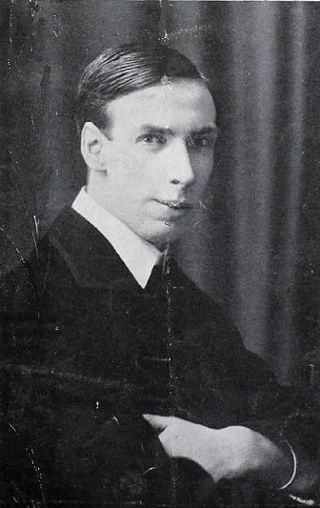
P. T. Selbit (1881–1938) was an English magician, inventor and writer who is credited with being the first person to perform the illusion of sawing a woman in half. Among magicians he was known for his inventiveness and entrepreneurial instinct and he is credited with creating a long list of successful stage illusions.
A trick deck is a deck of playing cards that has been altered in some way to allow magicians to perform certain card tricks where sleight of hand would be too difficult or impractical.
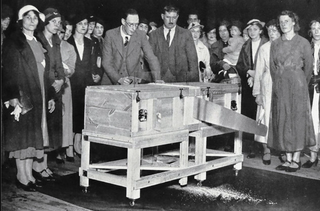
Sawing a woman in half is a generic name for a number of stage magic tricks in which a person is apparently cut or divided into two pieces.
Metamorphosis is the name of a stage illusion invented by John Nevil Maskelyne, but most often associated with famous escape artist Harry Houdini and performed to some renown by The Pendragons, among others. It is also known amongst magicians as the Substitution Trunk.

Harry Bouton Blackstone was a famed stage magician and illusionist of the 20th century. Blackstone was born Harry Bouton in Chicago, Illinois. He began his career as a magician in his teens and was popular through World War II as a USO entertainer. He was often billed as The Great Blackstone. His son Harry Blackstone Jr. also became a famous magician. Blackstone Sr. was aided by his younger brother, Pete Bouton, who was the stage manager in all his shows. Blackstone Sr. was married three times. Blackstone Jr. was his son by his second wife.

David Frederick Wingfield Verner, better known by his stage names Dai Vernon or The Professor, was a Canadian magician.
The Indian rope trick is a magic trick said to have been performed in and around India during the 19th century. Sometimes described as "the world’s greatest illusion", it reputedly involved a magician, a length of rope, and one or more boy assistants.
The Zig-Zag Girl illusion is a stage illusion akin to the more famous sawing a woman in half illusion. In the Zig-Zag illusion, a magician divides an assistant into thirds, only to have them emerge from the illusion at the end of the performance completely unharmed.

Jim Steinmeyer is an American author, inventor, and designer of magical illusions and theatrical special effects. He holds four US patents in the field of illusion apparatus, including a modern version of the Pepper's Ghost illusion. Steinmeyer has consulted for many famous magicians, including David Copperfield, Doug Henning, Siegfried and Roy, and Lance Burton.

David Copperfield's laser illusion is an illusion performed by David Copperfield in several magic shows. The magician or his assistant is cut by a "laser" into two or more parts and starts walking.
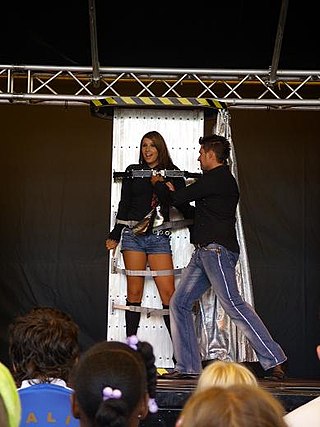
The Assistant's Revenge is a transposition illusion in which two performers change places. It was created by magician and inventor Robert Harbin.

The Aztec Lady is a stage illusion designed by British magician Robert Harbin. It is a classic "big box" illusion that involves an assistant in a cabinet and is probably best categorised as a restoration-type illusion.
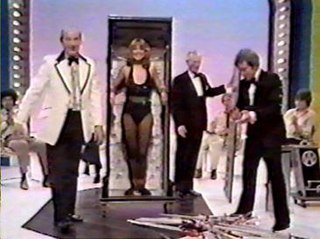
The Radium Girl is a stage illusion of the classic type involving a female assistant in a large box and is probably best categorised as a penetration or restoration-type illusion. Its origins and history are much less well documented than those of many other "big box" illusions, but some sources indicate it might be one of the earliest examples of that type of trick. References and picture captions indicate it was the creation of British magician and designer Val Walker.
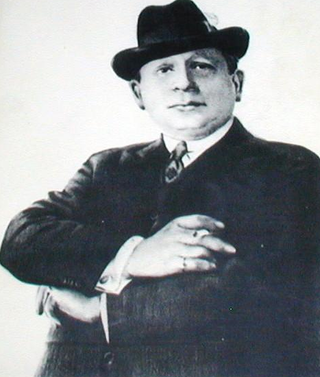
Horace Goldin was a stage magician who was noted for his rapid presentation style and who achieved international fame with his versions of the sawing a woman in half illusion.

A magician's assistant is a performer in a magic act who is not billed as the magician or principal name in the act.
Stage illusions are large-scale magic tricks. As the name implies, stage illusions are distinct from other types of magic in that they are performed a considerable distance away from the audience, usually on a stage, in order to maintain the illusion. Stage illusions usually use large props and may involve the use of assistants or large animals. Examples of stage illusions include sawing a woman in half and levitation.
Platform magic is magic that is done for larger audiences than close-up magic and for smaller audiences than stage magic. It is more intimate than stage magic because it does not require expensive, large-scale stage equipment and can thus be performed closer to the audience and without a stage. Many of the tricks performed by platform magicians are sufficiently angle-sensitive as to make them impossible to perform as micromagic. Most working magicians are parlor/platform magicians.

Magic, which encompasses the subgenres of illusion, stage magic, and close-up magic, among others, is a performing art in which audiences are entertained by tricks, effects, or illusions of seemingly impossible feats, using natural means. It is to be distinguished from paranormal magic which are effects claimed to be created through supernatural means. It is one of the oldest performing arts in the world.

A levitation illusion is one in which a magician appears to defy gravity by making an object or person float in the air. The subject may appear to levitate unassisted, or it may be performed with the aid of another object in which case it is termed a "suspension".













